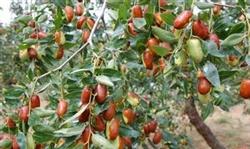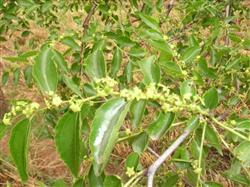Integrated control of jujube rust
Jujube rust, also known as jujube fog, often causes a large number of fallen leaves during the fruit expansion period, shrinks the diseased jujube fruit, reduces the sugar content in the pulp, and is mostly inedible. Due to the harm of rust, the yield is seriously reduced and the varieties become inferior, which directly affects the economic income of farmers. after the early defoliation of serious diseased trees, there will be secondary sprouting, affecting the yield of the coming year. Therefore, comprehensive measures must be taken for early prevention and control in order to minimize the loss caused by the disease. Jujube rust began to occur in early July, occurred in large numbers after August, and continued to re-infect, resulting in a large number of fallen leaves. In the prevention and control, we should give priority to agricultural control, supplemented by chemical control, seize the favorable control period, improve the control effect and reduce the occurrence of diseases. Thoroughly clear the garden in late autumn every year, remove the residual diseased fruit and leaves, clean the fallen leaves and fruits, concentrate on burning or burying deeply, and reduce the pathogens of overwintering. At the same time, dig deep in winter, bury germs deeply and dig up some pests so that birds can eat or freeze to death. At the same time, it can improve the physical and chemical properties of soil and create conditions for the healthy growth of jujube trees. According to the investigation of scientific fertilization, jujube rust occurs seriously in jujube orchards with poor soil fertility, weak tree potential, low yield and poor quality. Therefore, it is necessary to apply fertilizer scientifically, improve soil fertility, improve sufficient nutrition for jujube growth and development, and improve jujube disease resistance. In fertilization, base fertilizer should be re-applied, mainly organic fertilizer, combined with phosphorus and potassium fertilizer; flower fertilizer should be sprayed mainly by spraying foliar fertilizer at flowering stage, which can be sprayed with 0.3% rape 0.5% potassium dihydrogen phosphate solution; supplementary fruit fertilizer should be applied mainly with the combined application of nitrogen, phosphorus and potassium quick-acting fertilizer. The elimination of stagnant water in jujube orchard for a long time will cause jujube fruit to fall off, a large number of roots to die, and jujube rust to aggravate. Therefore, low-lying areas that are prone to stagnant water should be drained in time during the rainy season. And timely deep ploughing, loose garden soil, promote root activity, reduce jujube garden humidity, reduce the harm of rust. Reasonable pruning of jujube orchards with high planting density and exuberant growth should be properly pruned to facilitate ventilation and light transmission, enhance tree potential and improve tree disease resistance. Pruning is mainly based on branch thinning, and new jujube heads germinated on jujube strands and new jujube heads germinated in the crown should be removed in time if they are not used, so as to reduce nutrition consumption, improve ventilation and light transmission, resist rust, increase fruit setting rate and improve fruit quality. Chemical control is mainly sprayed with 200 times Bordeaux solution in early July for protection. Spray 200 times Bordeaux liquid again in early August. 70% methyl topiramate wettable powder 800 times liquid can also be used for spray control to control the occurrence and epidemic of jujube rust.
- Prev

Three tricks for jujube trees to sit on fruit
First, rational chemical control. Before flowering (around the beginning of May), each big tree was topdressing 0.5 kg urea and 0.25 kg urea per tree, and the compound fertilizer of N, P and K was applied again at the young fruit development period after flowering (mid-late June), about 0.75 kg per tree. Spray 10~50ppm gibberellin solution at the early stage of flowering or in full bloom.
- Next

Fertilizer and water management of jujube soil
Jujube trees have a long flowering period and like to be wet and afraid of dry. When 60% of the flowers are in full bloom, the jujube flowers can be evenly sprayed with water every 2-3 days for 2-3 times, which can increase the fruit setting rate. Spray 0.5% urea and 0.4% potassium dihydrogen phosphate or Tianrun No.1 solution every 5 to 7 days when jujube blossoms bloom for more than 3.
Related
- Moge, come on! The staff of the peasant association in the producing area of cantaloupe were frightened when the crowd gathered.
- Causes and Solutions of low Fruit setting rate of Apple
- Symptoms and control measures of passion fruit virus disease
- Fruit growing lesson: how do apple orchards keep high yields?
- Can you build orchards in the mountains? What are the pros and cons?
- How to manage the coloring period of Crisson grape?
- This paper introduces the processing technology of two kinds of fig products.
- How much is a month for retired teachers in rural areas by 2020?
- How can strawberry planting increase sugar content? We should pay attention to management in many aspects.
- What are the cultivation techniques on how to improve the yield of golden fruit?

